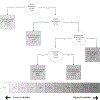Using recursive partitioning to predict presence and severity of suicidal ideation amongst college students
- PMID: 38728739
- PMCID: PMC11550263
- DOI: 10.1080/07448481.2024.2351419
Using recursive partitioning to predict presence and severity of suicidal ideation amongst college students
Abstract
Objective: Predicting the presence and severity of suicidal ideation in college students is important, as deaths by suicide amongst young adults have increased in the past 20 years.
Participants: We recruited college students (N = 5494) from ten universities across eight states.
Method: Participants answered three questionnaires related to lifetime and past month suicidal ideation, and an indicator of suicidal ideation in a DSM-5 symptom measure. We used recursive partitioning to predict the presence, absence, and severity, of suicidal ideation.
Results: Recursive partitioning models varied in their accuracy and performance. The best-performing model consisted of predictors and outcomes measured by the DSM-5 Level 1 Cross-Cutting Symptom Measure. Sexual orientation was also an important predictor in most models.
Conclusions: A single measure of DSM-5 symptom severity may help universities understand suicide severity to promote targeted interventions. Though further work is needed, as similar scaling amongst predictors could have influenced the model.
Keywords: College students; recursive partitioning; suicide.
Figures
References
-
- Walsh CG, Ribeiro JD, Franklin JC. Predicting Risk of Suicide Attempts Over Time Through Machine Learning. Clinical Psychological Science. 2017;5(3):457–469. doi: 10.1177/2167702617691560 - DOI
MeSH terms
Grants and funding
LinkOut - more resources
Full Text Sources
Medical
Miscellaneous


